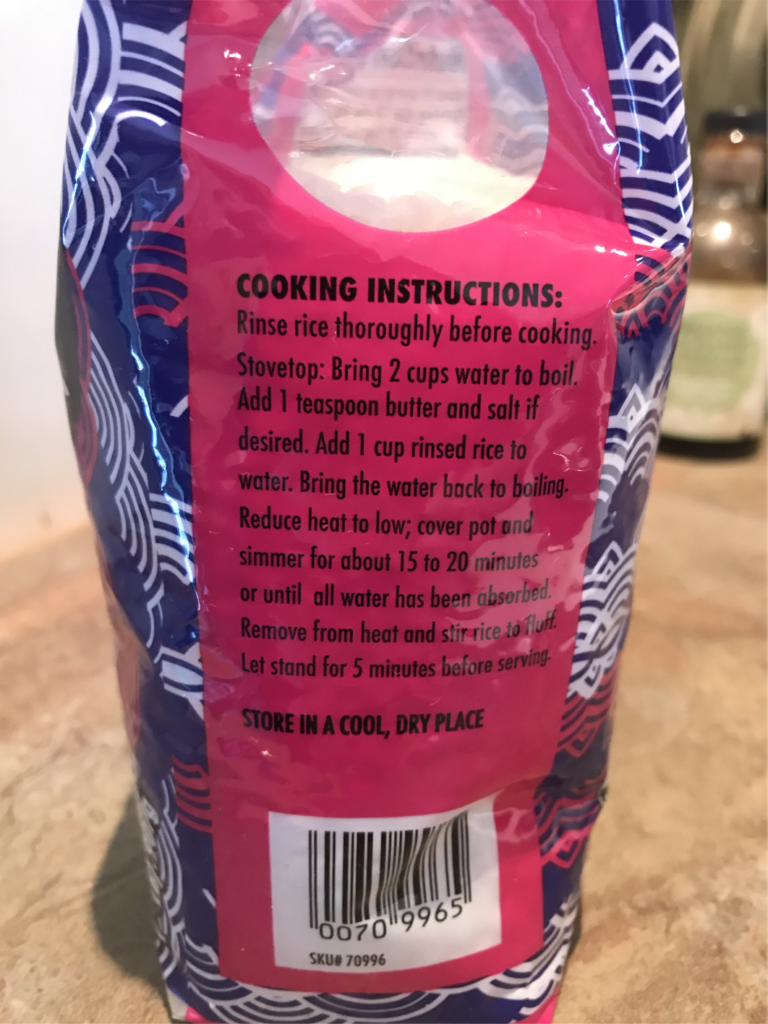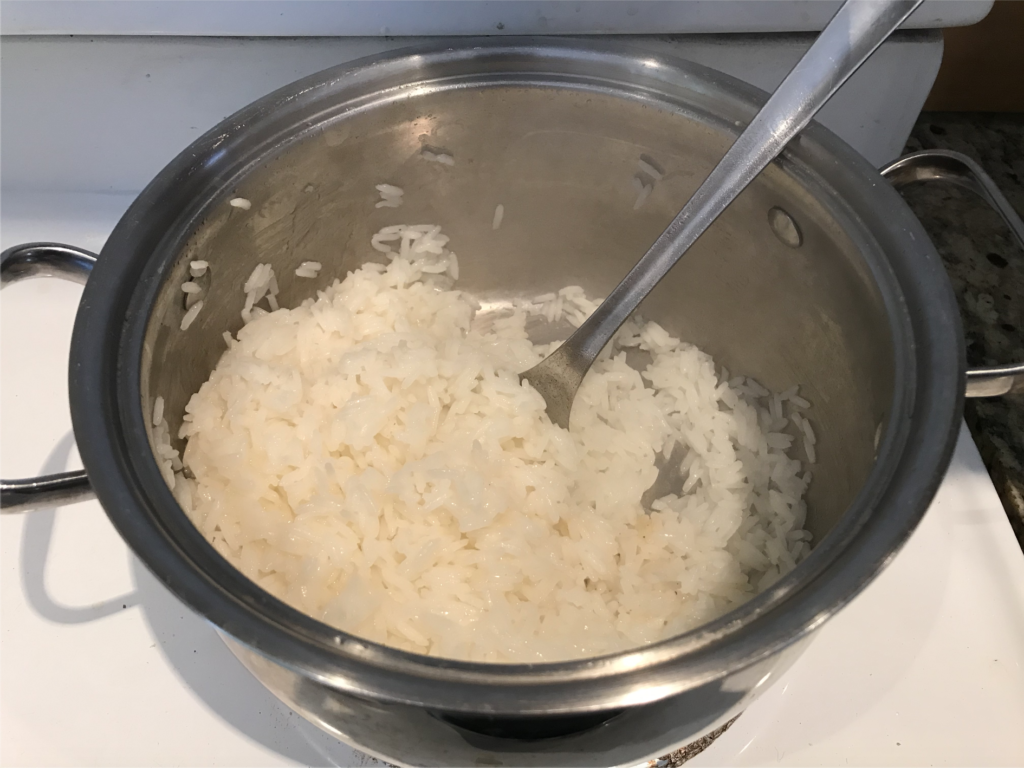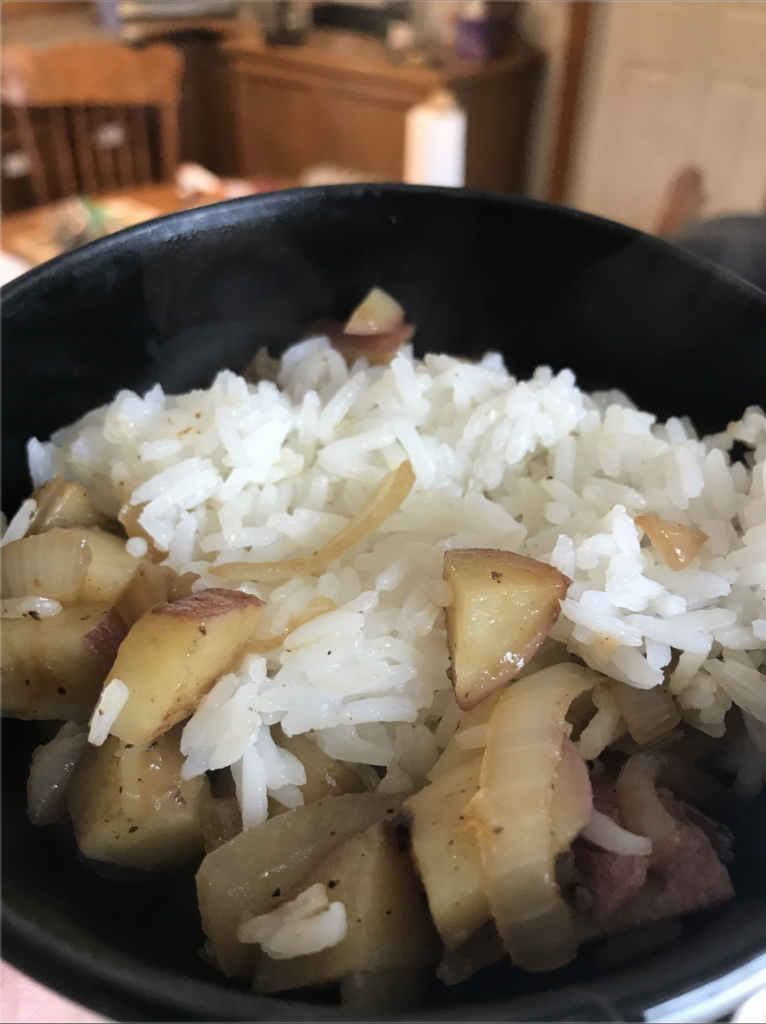If you’re wondering whether it’s worth buying jasmine rice from Trader Joe’s, then you’ve come to the right place. I went ahead and sampled some, and I’ll be diving into my experience here, so keep reading.
Unsurprisingly, Trader Joe’s doesn’t just sell one variety of jasmine rice. At my local TJ’s, I found three different varieties–Trader Joe’s Brown Jasmine Rice in a 3-lb bag (dry, non-organic), Trader Joe’s Organic Jasmine Rice, and a precooked version of the organic jasmine rice in the frozen foods aisle.
To my own tastes, I decided to try Trader Joe’s Organic Jasmine Rice from Thailand, which comes in a 32-oz package and can be found in the dry foods aisle near the other rices, beans, and grains. This is the newest of TJ’s jasmine rice offerings, first hitting shelves in 2021.
TJ’s Organic Jasmine Rice is certified organic by the USDA and contains only one ingredient, which I love! And yes–it’s really sourced directly from Thailand. Trader Joe’s has yet to publicize who their Thai rice suppliers are, but they typically work with a handful of farmers to source their regional and imported products.
Now let’s get into it… is this rice any good?
Even if you’ve only cooked rice a few times, you’re probably familiar with how finicky it can be, not to mention how long certain varieties can take to fully cook. It took me a long time to nail my rice-cooking technique, and sometimes I still manage to not get it exactly right.
But cooking this Trader Joe’s Organic Jasmine Rice was an absolute breeze! True to the package’s instructions, the rice was fully cooked in about 15 minutes.
To cook, I followed the instructions listed on the packaging, which recommend using a 2:1 ratio of water to rice. I honestly wasn’t convinced at first that two cups would be enough water, but I was wrong! I used two cups of water and one cup of rice, and that was the perfect amount.
The package also recommends adding a teaspoon of butter and salt to the rice water, which was a great suggestion. The butter gave the rice an extra kick of creamy flavor. It seemed a bit indulgent at first, but I definitely didn’t regret it!
Make sure to keep an eye on your pot as the rice is cooking, but resist the urge to remove the lid too often as this will release important moisture. But I definitely recommend checking on your rice at about 15 minutes, because I have a feeling mine would have started to burn or at least stick to the pan if I had cooked it for the full 20 minutes that the bag suggests.
If you’re not a fan of cooking on the stovetop, then I don’t have the best news for you because you really shouldn’t try cooking this kind of rice in the microwave. If you’re looking for a microwavable version of this same product, check out TJ’s frozen version of their Organic Jasmine Rice. It’s the same stuff! Just easier to make, which is always a bonus.
When cooked, Trader Joe’s Organic Jasmine Rice has an amazingly soft and creamy texture which probably means that the rice is quite fresh. Old rice can be brittle and tends to feel dry even after being cooked. But this rice has some of the nicest texture I’ve experienced, especially for rice I made myself. As far as flavor goes, TJ’s Organic Jasmine Rice has a delicate and aromatic flavor, which is exactly what you want from high-quality jasmine rice.
I decided to combine my jasmine rice with some caramelized onions, pan-fried potatoes, and two fried eggs. I topped everything with some spices, including a dash of Trader Joe’s Crunchy Chili Onion (which I tend to put on everything!).
Although I didn’t combine my rice with any traditional Thai flavors, this TJ’s rice would be a perfect base for any traditional Thai rice dish, like Thai fried rice, coconut rice, or Thai curry.
Here’s a look at my finished dish, topped with some rustic fried eggs and TJ’s Crunchy Chili Onion:
Now let’s take a minute to look at the nutritional value of this rice, since that can vary quite a bit between rice varieties. Unfortunately, white rice isn’t known for being particularly high in vitamins and minerals, so you won’t find much nutrition in TJ’s Organic Jasmine Rice.
Trader Joe’s Organic Jasmine Rice doesn’t list any critical vitamins or minerals on its nutritional facts label. In fact, all this rice contains (as far as we can tell from the label) are calories from carbohydrates. A quarter of a cup of TJ’s Organic Jasmine Rice contains 160 calories (which really isn’t a problem as part of a larger meal) and provides you with 36 grams of carbohydrates.
But before you write this stuff off as unhealthy, it’s important to remember that carbs aren’t always bad. Our bodies actually rely primarily on carbohydrates to function. That’s where we get the bulk of our energy to live and thrive throughout the day.
But of course, not all carbs are created equally. That’s why you’ll hear things like “simple carbs” and “complex carbs.” Unfortunately, white rice such as jasmine rice is definitely on the simpler side of carbs, so it would probably be best not to eat this stuff every day otherwise you’d be missing out on some critical vitamins and minerals that you can get from other healthier carbs.
If you’re looking for a more complex version of Trader Joe’s Jasmine Rice, try their Brown Jasmine Rice. This can be found right next to the Organic Jasmine Rice. While it’s not organic, it does offer a significantly higher nutrient content than its organic counterpart.
Trader Joe’s Brown Jasmine Rice contains 7 grams of fiber per serving, along with 6% of your daily value of iron and 2% of your DV of potassium.
If you’re wondering why brown jasmine rice has more nutritional value than regular jasmine rice, it’s because the regular white version is pretty heavily processed.
According to Healthline.com… “All white rice starts out as brown rice. A milling process removes the rice’s husk, bran, and germ. This process increases white rice’s shelf life but removes much of its nutrition, including fiber, vitamins, and minerals.” There you have it. It’s a bummer, but it’s true.
So, while TJ’s Organic Jasmine Rice may not be the most nutritious rice variety out there, it’s not the worst thing to make a meal with on occasion. Just make sure you’re supplementing with plenty of nutrient-rich veggies and protein sources.
Final Verdict
And finally, there’s the question of whether or not Trader Joe’s Organic Jasmine Rice is any good… take it from me. It’s really good. And I’m not just saying that. I’m pretty picky when it comes to foods, especially foods like rice that tend to vary so much in quality. But I can confidently say that I would buy this rice again.
Each bag of Trader Joe’s Organic Jasmine Rice contains about five cups of rice, which means you could make dinner for a whole week with just one bag. And at just $3.69 per bag, that’s pretty unbeatable if you ask me. (That’s only 18 cents per serving!)
Overall, TJ’s has a great selection of jasmine rice varieties, including dry options, frozen options, and organic options. The healthiest jasmine rice offering at TJ’s is their Brown Jasmine Rice (but be aware that it’s not organic). Whatever version you decide to make, you can feel pretty confident that it will be a wise buy. Next time you need to buy some jasmine rice, look no further than your local Trader Joe’s.











